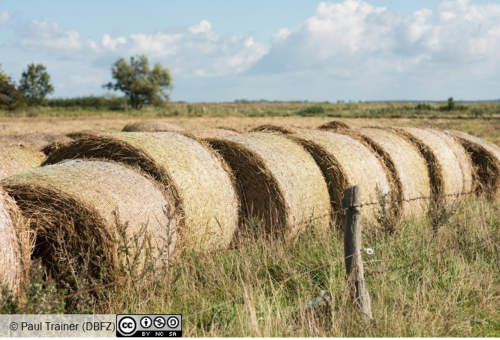Example: Cereal Straw
Getreidestroh. Copyright: Paul Trainer (DBFZ)
Which single biomass is considered? What type of biomass is it?
Straw is a by-product of agriculture; a distinction is made between different types of straw, which are dependent on the actual cultivated biomass. Typical types of straw in Germany include corn straw, cereal straw from wheat, rye, barley, oats or triticale and rapeseed straw. In this example we limit ourselves to the consideration of cereal straw.
What restrictions and competition for use must be considered?
The greatest competition for use is - as already mentioned several times - the use of cereal straw to maintain the humus balance. Apart from the humus balance, cereal straw is often used as animal bedding. Here it is necessary to consider whether there are alternatives or whether cascading use makes sense.
What are the energy pathways for grain straw?
Straw can be used for energy in different conversion paths. On the one hand it can be used as a raw material in bioethanol plants or SNG plants (SNG = Synthetic Natural Gas) for the production of biogenic fuels of the 2nd generation. In addition to fuel production, straw can also be used as a raw material (usually silage) in biogas plants for methane production. The direct combustion of straw in heating plants or in a combined heat and power plant is also possible.
The raw material requirement depends on the conversion technology. Small, decentralised solutions such as heating plants or biogas plants with an output between 100 kW and 2 MW have a relatively low raw material requirement of a few thousand tonnes of straw per year (approx. 250 - 3.000 tTM per year, depending on the size of the plant). Combined heat and power plants and plants for fuel production have a significantly higher raw material requirement of approx. 15,000 - 350,000 tTM per year. These central plants are only possible in areas with high straw production, as the transport should be economical and sustainable. For transport distances, it should be noted that straw has a low energy density and therefore large volumes have to be transported. The CO2 and pollutant emissions of the transport vehicles must also be taken into account for a sustainable consideration. (Zeller et al. 2011)
Further information on transport distances and raw material requirements of individual technologies can be found here:
Publication series of the BMU funding programme Energetische Biomassenutzung Volume 04 (in German).
Which factors are necessary to calculate the potential?
The theoretical potential is calculated indirectly via the cultivated area of the main product, e.g. cereals. The ratio of grain to straw depends on the type of grain. In addition, the water content must be taken into account; the literature assumes a water content of 14%. For the calculation of the technical biomass potential, deductions for the humus balance and the technical salvage rate are taken into account. Both factors are dependent on soil conditions, weather conditions and the type of cultivation and salvage. Values for the factors can also be taken from the cereal straw data sheet.
How can the results be mapped so that laypersons can interpret them well?
The cereal straw volume and the associated sustainable biomass potential were calculated for Germany in different resolutions (federal state, county, km²) and spatially represented. You can find maps on straw potential and the interactive bioenergy atlas on the micropages of the DBFZ. For Bosnia and Herzegovina a similar atlas has been prepared; here the resolutions county, entity and national are available.
